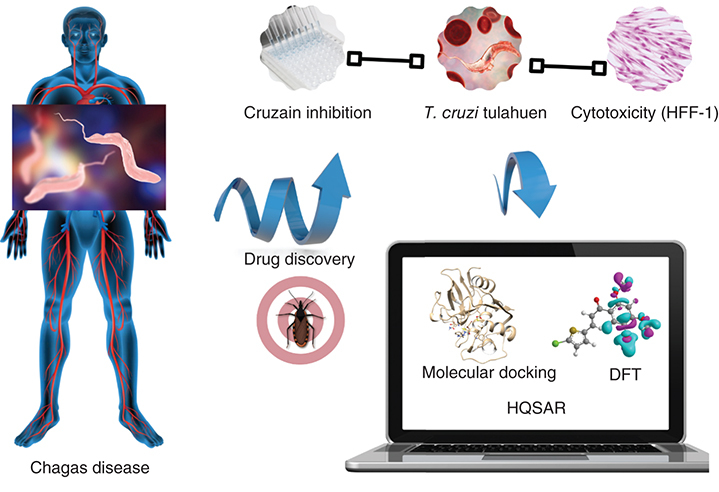Abstract
Background: Chagas disease is a neglected tropical disease that affects millions of people worldwide and for which no effective treatment is available. Materials & methods: 17 chalcones were synthesized, for which the inhibition of cruzain and trypanocidal activity were investigated. Results: Chalcone C8 showed the highest cruzain inhibitory (IC50 = 0.536 μm) and trypanocidal activity (IC50 = 0.990 μm). Molecular docking studies showed interactions involving Asp161 and the thiophen group interacting with the S2 subsite. Furthermore, quantitative structure–activity relationship (q2 = 0.786; r2 = 0.953) and density functional theory studies were carried out, and a correlation between the lowest unoccupied molecular orbital surface and trypanocidal activity was observed. Conclusion: These results demonstrate that these chalcones are worthwhile hits to be further optimized in Chagas disease drug discovery programs.
Graphical Abstract

Supplementary data
To view the supplementary data that accompany this paper please visit the journal website at:www.tandfonline.com/doi/full/10.2217/epi-2016-0184
Author contributions
A de Oliveira: formal analysis, resources, supervision, writing – original draft, investigation. M Valli: formal analysis, writing – original draft, investigation. L Ferreira: writing – review and editing. J Souza, R Krogh, L Meier, H Abreu, B Voltolini, L Llanes: investigation. R Nunes, A Braga: conceptualization, formal analysis, supervision. A Andricopulo: conceptualization, formal analysis, resources, supervision, project administration.
Financial & competing interests disclosure
The authors acknowledge the National Council for Scientific and Technological Development (CNPq), the Co-ordination for the Improvement of Higher Education Personnel (CAPES, finance code 001) and the Sao Paulo Research Foundation (FAPESP, grants 2013/07600-3, 2015/06392-3 and 2019/05967-3), Brazil, for financial support. The authors have no other relevant affiliations or financial involvement with any organization or entity with a financial interest in or financial conflict with the subject matter or materials discussed in the manuscript apart from those disclosed.
No writing assistance was utilized in the production of this manuscript.
